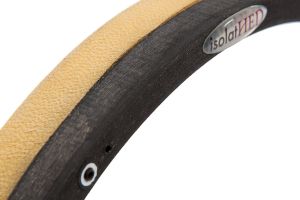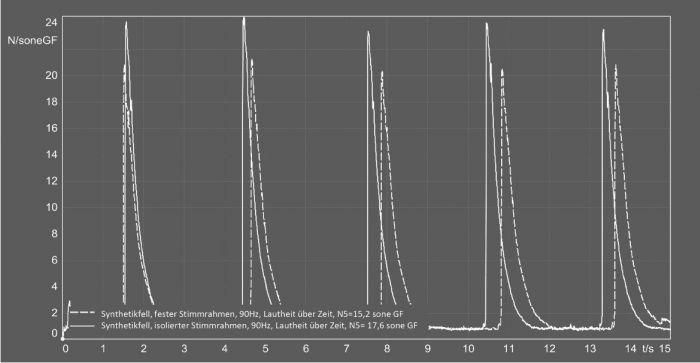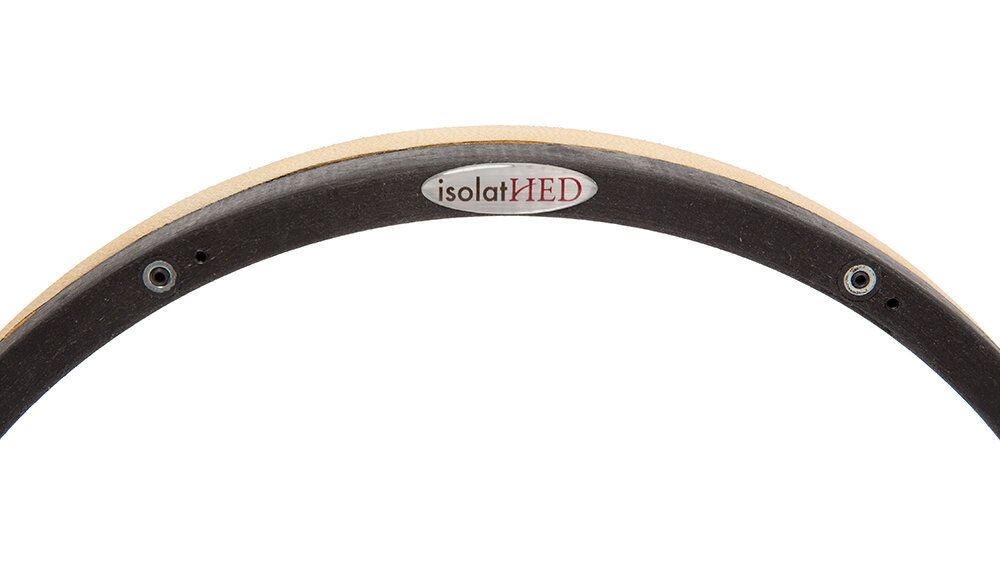The IsolatHED Technology

The isolatHED technology
In today’s bodhrán world, tunable bodhráns using a tuning rim inside the frame are quite common.
When, half a century ago, the tuning rim found its way into the bodhrán, this really changed the drum’s tonal characteristics. Before that, the wooden frame had been the only part of the drum that caused the drum skin to vibrate. Today, there are many more parts involved. Components such as reinforcement frames, tuning pegs, pressure screws, tuning screws, and holding screws influence the drum’s vibrational behavior through their own natural vibrations. Depending on construction and material, natural vibrations can build up or cancel each other out; they can become amplified or dampened. This can lead to an overall unbalanced frequency spectrum.
A bodhrán player may notice frequency gaps when modulating the sound of the bodhrán with the skin hand. There may be certain areas in which the drum sounds dampened, empty, or “dead“. The more the overall sound of the bodhrán is influenced by the natural vibrations of its components, the higher the potential for interferences and unpredictability.
"When I started making drums, I often heard that the tuning rim should have as much friction and contact with the outer frame as possible to ensure the best possible transfer of vibration. But even back then, I wasn’t so sure about that. After all, it’s the skin that is supposed to vibrate, not the frame. And since the frame is also in contact with the player’s body (arm, upper body, thigh), its vibrations are dampened anyway.
So wouldn’t it be better if the tuning rim worked as much as possible with the skin and as little as possible with the outer frame? Wouldn’t it make sense to keep the components that might interfere with the vibrations away from the vibrating system as much as possible?
When I introduced the CoreLine in 2012, this was the first time I used an inner tuning rim that didn’t have any contact with the outer frame, except for the six points where the tuning screws touched the frame. Even before that, I had already changed all my tuning systems by using one continuous inner frame instead of several individual tuning pegs. I did this to reduce the number of individual parts and different materials, and, thus, reduce the amount of natural vibration within the vibration system.
I have now succeeded in decoupling the contact points of the tuning screws acoustically. This means that the tuning rim is now the only component still in direct contact with the drum skin. The result is a drum inside a drum, so to speak: First, there is the outer frame, which is in contact with the player’s body, holds the drum skin, and supports all components of the tuning system. Second, there is the independent tuning rim, which takes the sound off the drum skin like a pickup or a bridge."
How does it work?
By using rubber-encased pressure screws that are embedded in the tuning rim. This preserves the possibilities of a multi-point tuning system without dampening the tuning rim or causing it to “float.”
As a result, the brilliance of sound is significantly improved, and the frequency spectrum becomes much more homogeneous. As less energy is absorbed by the main frame, there is also a measurable increase in loudness.

Scientific studies
Studies carried out at the University of Munich showed that, with the same stroke impulse, the isolated tuning frame (in this case, with a synthetic skin and a basic tone of 90hz), can generate a higher loudness (volume perceived by the human ear) (solid line) than a classic tuning frame. The diagram shows five individual strokes for the same drumskin, the same basic tone, and the same stroke impulse.
Please note
In addition to the isolated, rubber-coated pressure point, each isolatHED tuning frame also has a regular, traditional pressure point (the second, small black point next to it). When the tuning frame is entirely relieved and can be loosely rotated, it can be isolated either completely or partly by shifting to the relevant pressure point.
This gives (experienced) players the opportunity to experience the different sound/vibration behaviour of each pressure point.
In both cases, the tuning frame remains separated from the outer drum frame. Only for the traditional pressure point, there is a higher level of structure-borne sound transmission due to the tuning mechanics, which is prevented for the rubber-coated pressure point.
A traditional pressure point can, for example, be useful if the drumskins are very uneven or thick. Since, however, most players perceive the entirely isolated pressure point as a considerable sound improvement, our drums are delivered with the isolatHED pressure point position.
Players who aren’t that experienced don’t have to worry about the second pressure point.
Rolf Wagels
"I am always looking for a clear and defined tone in my drum. When Christian first told me about IsolatHED tuning rim, I was intrigued: could this be the next big thing? And it proved to be the next big thing, both in the laboratory testing but also when I tested it in person."
Andy Kruspe
"From improved accuracy and ease of tuning to overall improvement of sound from my existing skins, the IsolatHED tuning rim has taken a great drum and made it better. This is an excellent addition to the ChangeHED system."
Martin O´Neill
"Drum is very good. At first I didn't like it as it was almost too bright and didn't feel as controlled but as soon as I went into the studio it was instantly better. Open notes sound mega!! Night and day compared to the drum I was playing. I used it for 3 days in the studio and couldn't go back to the other one. So that's a clear thumbs-up from me!"
Stevie Moises
"I was instantly convinced! The skins react even more sensitively now, tone modulation is even more precise, and the sound is even louder and clearer, too! With the new technology, I’ll be able to play even more dynamically, and as a bonus, the drum will be better heard when I’m playing with the band. All of these improvements also make a considerable difference when using a microphone. Even our sound engineer is a fan of isolatHED!"


